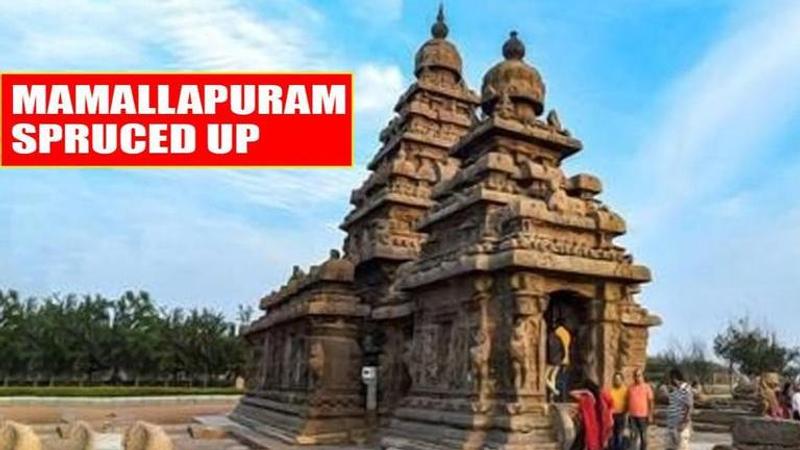Published 12:02 IST, October 9th 2019
Spruced up Pallava-era sculptures ready for PM Modi, Xi Jinping visit
The ancient Mamallapuram monuments, spruced up ahead of this week's Indo-China summit, is a quiet cue to the artistic genius of Pallava era artisans.

The ancient Mamallapuram monuments, spruced up ahead of this week's Indo-China summit, is a quiet cue to the artistic genius of Pallava era artisans, who created poetry in stone to bring alive several ideas like the time of the day, long before the clock was invented. As Prime Minister Narendra Modi and Chinese President Xi Jinping are set to visit the over 1,000-year-old monuments, a deeper study of the scintillating sculptures brings out the brilliance of its creators.
T Satyamurthy on Mamallapuram
On the Mamallapuram monuments, noted archaeologist T Satyamurthy said, "The Pallava artisans excelled all their counterparts anywhere else." Illustrating his point, the renowned scholar, who was formerly superintending archaeologist of the Archaeological Survey of India, referred to the grand work of Arjuna's penance to get "Pasupatastra" from Lord Shiva.
"In the entire frame, there are 64 demi-gods, one temple, 13 human beings, 10 elephants, 16 lions, nine deer and antelopes, two sheep, two turtles, one rabbit, one wild pig, one cat, 13 rats, seven birds, four monkeys, one iguana (double-tongued lizard) and eight trees," Satyamurti told PTI in an interview.
Lord Shiva's standing posture with four arms is striking and his lower hand shows "varada-mudra", denoting grant of boons to Arjuna. The Lord wears "Jata-Mukuta," (a crown of artfully plaited braids) with Chandra (moon) decorating it at the Centre and along with "ganas" (attendants) he arrives to shower boons and all of these are skillfully sculpted. "It is unique in many respects, including the selection of the rock for such execution." Two large boulders (192 x 92m) with a narrow fissure in between were selected to represent a series of rows of gods and goddesses and other natural sceneries. A narrow split in between the boulders divides the entire scenery into two blocks vertically and the fissure is converted into a flowing river. Nagas and Naginis are carved in this gap, further strengthening the scene as the event that took place on the banks of a river.
Again, the depiction is divided into two horizontal planes and celestial happenings over a huge hill are depicted in the upper plane. The lower plane shows day to day life scenes that generally took place on the banks of a river in ancient India. It includes rituals by Brahmins in front of a miniature Vishnu shrine. "The upper panel is found to be more animated with rows of gods and goddesses like the Chandra, Surya, pairs of Kinnaras, Siddhas, Gandharvas, and Apsaras all glancing at a central point where a sage stands on his left foot deeply engaged in penance," he pointed out. Apart from the celestials, there are hunters, sages, disciples and wild animals like the lion, tiger, elephant and boar.
"The group of elephants so faithfully true to nature are a real masterpiece, enhancing the charm of this wonderful carving."
The young ones nestle in the space between the legs of the parent and play with trunks, showing their delightful life. In the vicinity is a temple of Vishnu, where a number of sages are depicted in deep meditation. Below them are their disciples, one of them carrying water in a pot on his shoulder, another wringing out water from a wet cloth and a third engaged in "suryopasthana." Suryopasthana is a posture wherein the hands are joined together by interlocking fingers and are placed just above and in front of the forehead. The joined fingers are adjusted in a manner to create an opening through which the sun is seen as in "madhyanikam sandhyavandana," a prayer performed at noon.
"In accordance with dharma sutra texts,this prayer has to be performed at noon. The sculptor created this scene within the frame to indicate that the event took place at noon, hence, this miniature carving at the lowermost part of the great relief became a clock of the Pallava period," he noted.
A hermit is carved on the lowermost segment and he is on the southern side of the river, looking at the sun on the northern direction. "It indicates Uttarayan (movement of sun towards the north).. interestingly, the sun and moon are placed on both sides of the river over the sky. ... they are in opposite directions...such an astronomical position happens only on full moon day... through this, the "tithi" is indicated, which is the full moon day," he said. The season 'Vasanta ritu (spring)" is indicated by the fully ripened seasonal jackfruits in the forest.
"The event thus took place on full moon day of Vasanta ritu during uttaryana at noon and Lord Shiva granted a boon to Arjuna on this day and time, which is considered auspicious," Satyamurti said he was thankful to the late Kanchi Mahaswami, Chandrasekharendra Saraswati (1894-1994) for his guidance on areas, including suryopasthana, which was of great use to him in his work. The Shore temple and Five Rathas are also part of the group of monuments at Mamallapuram, which are about 1,300-years-old.
Updated 12:51 IST, October 9th 2019




